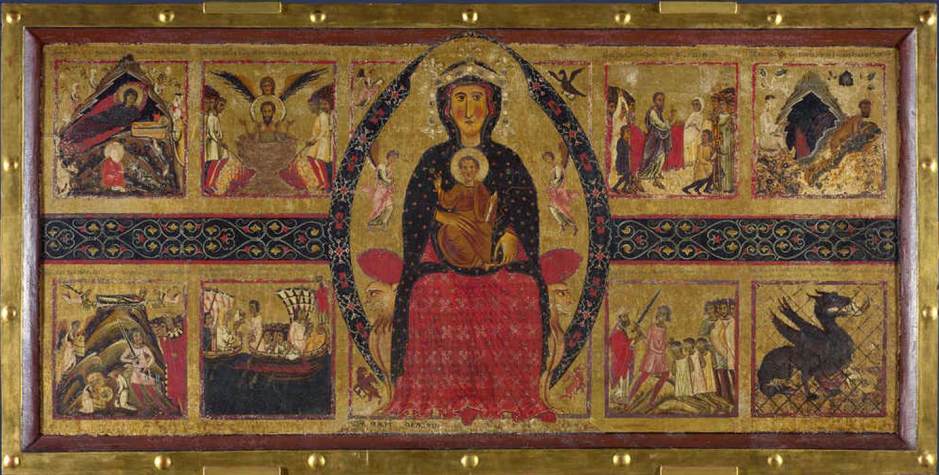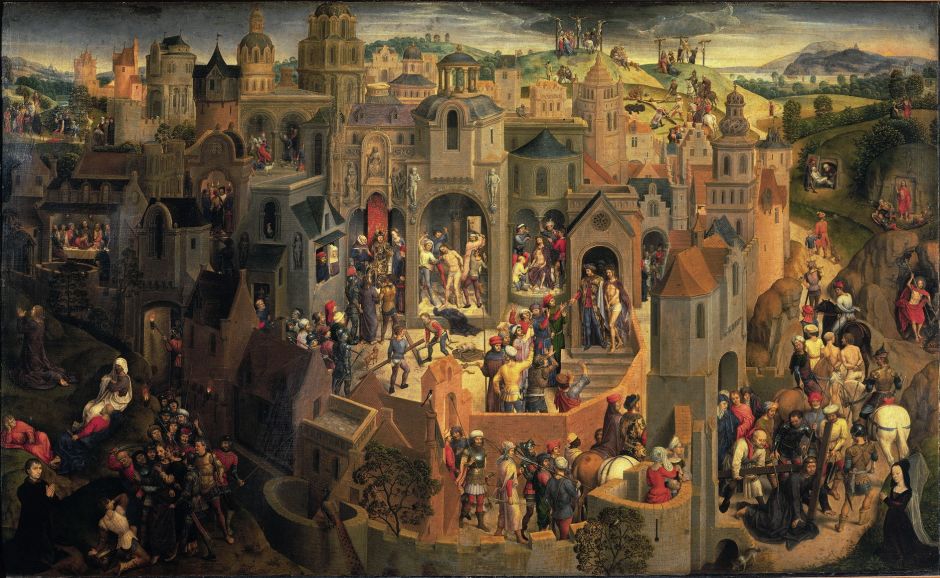In yesterday’s article, I looked at the narrative techniques used by the three fifteenth century artists who painted the superb frescoes in the Brancacci Chapel. They were telling relatively short and simple stories consisting of only two or three scenes. In this article, I look at a much greater challenge: telling the story of Christ’s Passion, leading up to the Crucifixion and Resurrection.
Although multiplex narrative is probably as old as painting itself, and was popular in classical Rome, it flourished in the Renaissance, tackling challenges like this.

Before the Renaissance, it wasn’t at all unusual to use multi-frame narrative, as in Margarito d’Arezzo’s The Virgin and Child Enthroned, with Scenes of the Nativity and the Lives of the Saints from about 1263-4.
The panel in the top left corner shows the Nativity, following which there are scenes from the lives of various saints, down to the lower right hand corner where Saint Margaret the Virgin (of Antioch) is swallowed by a dragon (the devil), and emerges from that dragon because the cross which she carries irritates the dragon’s innards. This series of frames is not unlike a modern ‘comic’ book.

Two hundred and fifty years later, Gaudenzio Ferrari uses the same technique in his Stories of The Life and Passion of Christ (1513). Here twenty frames cover the life of Christ around a central frame with four times the area of the others, showing the crucifixion. The frames are naturally (for the European) read from left to right, along the rows from top to bottom, although the crucifixion is part of the bottom row. This layout is commonly used for graphic novels.
At the top left is the Annunciation, and the sequence ends with the Ascension at the bottom right.

Little more than a decade later, Bernardino Luini’s masterwork, his vast fresco of the Crucifixion and Scenes from the Life of Christ (1529-31) dispensed with frames and tried to do what Masaccio had done so successfully: integrate multiple scenes into a single multiplex painting. Unfortunately, because of lighting equipment now installed in front of this fresco, it’s impossible to get a good image of it. I therefore offer the two best images (above and below) which I have been able to locate.
The painting is dominated by the three crosses of the Crucifixion, which stand almost full height, with Christ in the centre. The main sequence of scenes is in the upper tier, where Christ can be seen carrying his cross up to the place of execution (to the left of Christ’s feet), and his body is being taken away for the entombment (to the right). The lower tier shows various scenes at the site of the crucifixion itself, with the Marys comforting one another to the left.

Luini’s use of space isn’t as ordered as it might be, leaving the viewer to work hard to read his painting. Hans Memling devised what I think is clearer for his earlier Scenes from the Passion of Christ (1470-1).

Here each of the individual scenes making up the Passion as a whole is located in a different part of a fictionalised aerial view of Jerusalem. This does lead to some strange effects, though. For example, he shows no less than three separate crucifixions: at the upper right of the city is the first, with Christ laid on the cross but still on the ground. The second is above and to the left of that, where all three victims are seen on their crosses. The third and final scene is to the right of that, where Christ’s body is being brought down in a Deposition.
The buildings provide demarcated spaces for many of the scenes, almost framing them, perhaps. This is a technique used in illustrations for children’s books which we use to teach them how to read multiplex narrative, without really being aware of what we’re doing.

Towards the end of the southern Renaissance, Jacopo Tintoretto painted one of the major religious works of the sixteenth century in his vast Crucifixion (1565). He makes sophisticated use of space for multiplex narrative, in which its single image shows events at more than a single point in time – but in an ingenious and modern manner.
Naturally, the painting centres on Christ crucified, but the two thieves executed beside him are not shown, as would be traditional, already hanging from their crosses.

Instead, to the right of Christ, the ‘bad’ thief is still being attached to his cross, which rests on the ground. To the left of Christ, the ‘good’ thief is just being raised to the upright position. There is nothing in the well-known gospel accounts which actually makes this view anachronistic, but it is most probable that the crucifixions were more simultaneous.
It is thus an ingenious artistic device which shows the three executions at different times, but avoids the archaic repetition of figures or other content, as Tintoretto applies it to discrete passages within the whole.
Spaced out around the canvas are relevant sub-stories from that whole. At the foot of Christ’s cross is his group of mourners, including the Marys. Each of the crosses has attendant workers, busy with the task of conducting the crucifixion, climbing ladders, hauling on lines, and fastening each victim to his cross. This mechanical and human detail brings the scene to life and adds to its credibility, and grim process.

The crowd on the left is spread out. In the distance is a flag bearing the letters SPQR representing the Roman Empire, and its link through Pilate. Most faces are turned towards Christ, with their eyes wide in awe.

On the right, in a small rock shelter suggestive of a tomb, two men are gambling with dice. To the right of them, a gravedigger has just started his work with a spade. The ruling class, perhaps Herod himself, have turned up on horseback, and they too stare wide-eyed at Christ.
Two centuries later, Gotthold Ephraim Lessing, in his essay Laocoön (chapter 18), condemned painters for attempting to show more than one moment in time in the same image, which he considered was in “bad taste”. It seems such a shame that his ill-informed aesthetics should have so influenced artists ever since. I hope these two articles have demonstrated how the depiction of two or more moments in time can make wonderful visual narrative, once you know how to paint in four dimensions.

